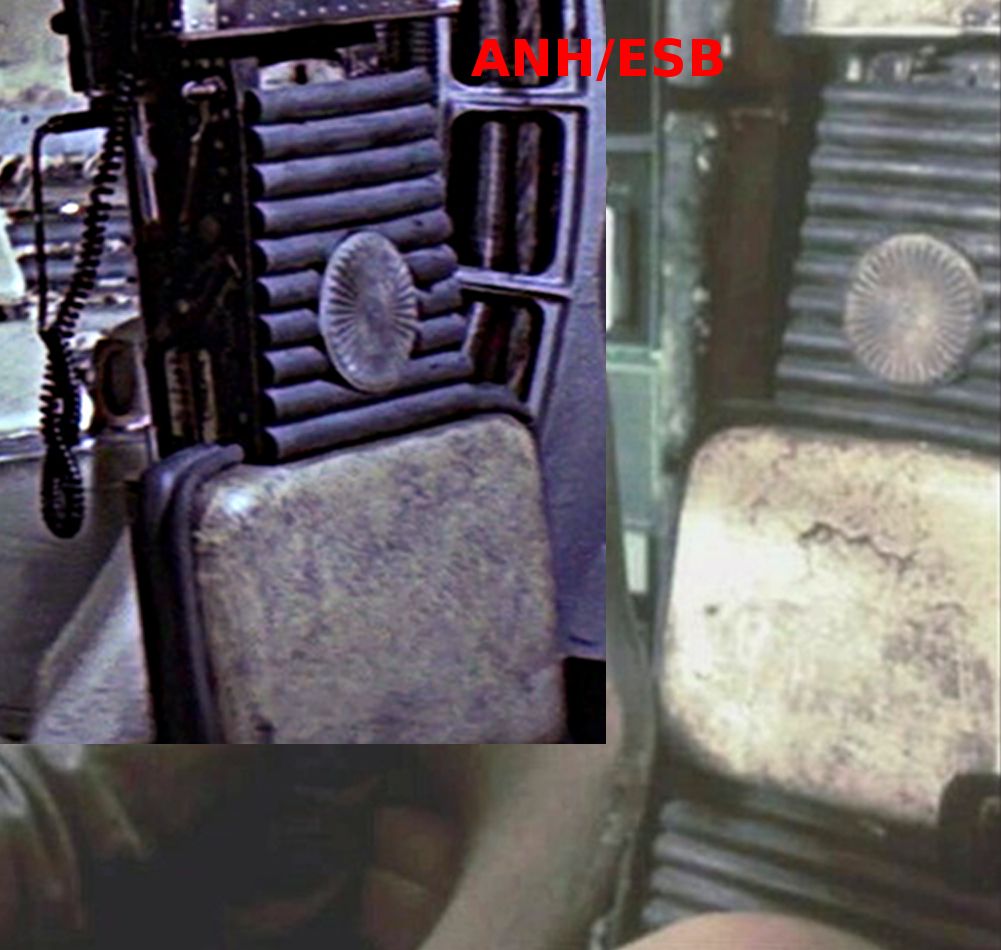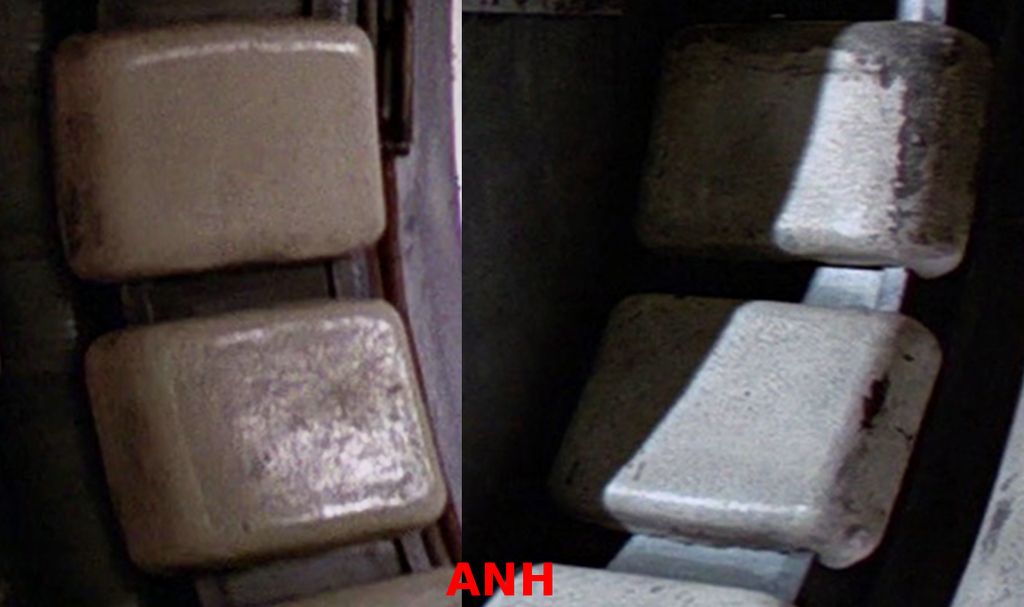You are using an out of date browser. It may not display this or other websites correctly.
You should upgrade or use an alternative browser.
You should upgrade or use an alternative browser.
Building The Falcon NAV chair
- Thread starter Stormy320
- Start date
Wavey
Sr Member
I think the back cushion is a fairly solid fibreglass or Modrock construction, set up in a similar way to the MF's wall pads but more refined like the seating around the table. In the pic you can see roughly what I'm thinking with the wall pad idea, a slightly raised rounded edge merged onto a flat middle area - but with the back cushion it's flattened out a little more.
The seat pad is a lil more cozy, looking very similar to a cushion seen in the cantina. It reminds me of a car seat riser cushion you could get at most garages at the time.
I'm still thinking of ways to make a similar set of cushions in black for my quad control nav seat lol. Does neoprene come in colours?



The seat pad is a lil more cozy, looking very similar to a cushion seen in the cantina. It reminds me of a car seat riser cushion you could get at most garages at the time.
I'm still thinking of ways to make a similar set of cushions in black for my quad control nav seat lol. Does neoprene come in colours?



WOW! What did you use for the padding?
Wavey
Sr Member
Just some ideas here as I've not decided on materials for mine yet but what helps is to think of the construction like this (see pic).
The original back looks to be made in 2 halves (or mirroring the look of the lower cushion and a little like the wall pads) with a noticable seem line seperating the top inch from the back inch (I'm guessing this back part is approx 2 inches deep).
This opens up a few ideas as to how cozy and durable the back cushion could be. If you plan to use the seat and sit in it, a completely solid back may eventually be a pain in the... back. But one idea is to have the detailed top inch solid (fibreglass or soft wood, etc) and the back inch in a high density white or light grey foam or neoprene - stick them both together and then weather. This means there will be cushioning and some movement when fidgeting about, answering your comlink or checking the hyperdrive status. I'm not sure how comfy this will be lol, as my chair is my office chair.
The idea can also be used for a fully solid back. If you want to make a buck in wood or clay and go as detailed as possible, then if it gets damaged over time you only have to cast another top inch and re-attach to the back part.
This could also be reversed, by having the top part in 1 inch white neoprene or some kind of closed-cell high density foam/rubber and the back inch in a solid material, as most chunky foams only dip about an inch. But this way around means carving out the rounded corners into a 'half bullnose' shape/profile and that could be tricky, unless there's a tool for rounding corners that will work on softer materials.
Some soft back material searches I've been looking at include: High Density Seat Foam, Closed-Cell Neoprene Sheet and Closed-Cell Polyethylene Sheet. Some 'closed cell' foams already have that irregular bumpy look which is good for weathering to sink in and cling on to and is easy to add all the dents and scrapes to with a hot-wire or soldering iron.
I'm still looking at different quick and easy ideas for the base materials though.

The original back looks to be made in 2 halves (or mirroring the look of the lower cushion and a little like the wall pads) with a noticable seem line seperating the top inch from the back inch (I'm guessing this back part is approx 2 inches deep).
This opens up a few ideas as to how cozy and durable the back cushion could be. If you plan to use the seat and sit in it, a completely solid back may eventually be a pain in the... back. But one idea is to have the detailed top inch solid (fibreglass or soft wood, etc) and the back inch in a high density white or light grey foam or neoprene - stick them both together and then weather. This means there will be cushioning and some movement when fidgeting about, answering your comlink or checking the hyperdrive status. I'm not sure how comfy this will be lol, as my chair is my office chair.
The idea can also be used for a fully solid back. If you want to make a buck in wood or clay and go as detailed as possible, then if it gets damaged over time you only have to cast another top inch and re-attach to the back part.
This could also be reversed, by having the top part in 1 inch white neoprene or some kind of closed-cell high density foam/rubber and the back inch in a solid material, as most chunky foams only dip about an inch. But this way around means carving out the rounded corners into a 'half bullnose' shape/profile and that could be tricky, unless there's a tool for rounding corners that will work on softer materials.
Some soft back material searches I've been looking at include: High Density Seat Foam, Closed-Cell Neoprene Sheet and Closed-Cell Polyethylene Sheet. Some 'closed cell' foams already have that irregular bumpy look which is good for weathering to sink in and cling on to and is easy to add all the dents and scrapes to with a hot-wire or soldering iron.
I'm still looking at different quick and easy ideas for the base materials though.

joberg
Legendary Member
Careful with the "padding" on a seat. Now, I know, some people are aware of this, but seating is generally transformed or "made hard" (as opposed to comfy) for the actor.
Why you ask? So the stomach muscles are still straight and the actor can deliver his lines with ease (trick used mainly in theater). So, don't be fixated on the inside of the seat, but more on the outside finish.
Why you ask? So the stomach muscles are still straight and the actor can deliver his lines with ease (trick used mainly in theater). So, don't be fixated on the inside of the seat, but more on the outside finish.
Darth Lars
Master Member
I find it hard to avoid knots from forming when laying fibreglass. You would have to use several layers to make it survive someone sitting on it.Using some standard foam and covering it with fiberglass? Would this work?
I think it would be better to cut it from MDF from the beginning if you want it hard.
I would use EVA foam and cover it in some pleather/vinyl that has some stretch to it - the stretch only to avoid folds in the corners. Or you could paint it in a few layers of a mix of latex milk and acrylic paint. Just be aware that latex/acrylic mix is whiter before it has dried. There might be some trick for better adhesion also, discussed over in some foam costuming thread.
Lt Washburn
Sr Member
Why fiberglass? I've never gotten the impression that they were that hard. My guess is a fairly hard foam rubber that has a bit of give, but is still fairly rigid. Closed-cell, to give that smooth surface look.
Similar threads
- Replies
- 10
- Views
- 1,238
- Replies
- 0
- Views
- 268
- Replies
- 2
- Views
- 636
- Replies
- 2
- Views
- 865




